The Western Roman Empire faced a series of challenges after the sack of Rome. This event greatly weakened the empire’s stability and hurt the reputation of its leaders. As control slipped, local powers began to challenge Rome’s authority, and crucial lands were lost, making it harder to maintain order.
Attempts to address these problems included military campaigns, new laws, and shifting alliances with outside groups. Despite these efforts, internal struggles and pressure from various groups, such as the Visigoths and Vandals, pushed the empire further into decline.
Key Takeaways
- The Western Roman Empire struggled with growing instability and loss of key regions.
- New laws and shifting alliances aimed to hold the empire together, but were not enough.
- Continued threats and internal strife weakened leadership and control.
Rome’s Fall and the Years that Followed
Invasions and Internal Troubles for the Western Empire
The Western Roman Empire faced threats from different groups, especially the Visigoths. After they set fire to Rome, law and order in the region started to break down. Rome’s leaders had trouble keeping control, and many governors in the provinces tried to break away. Key provinces, such as North Africa, were lost, making it hard for Rome to get enough grain and food.
Local rulers in places like Hispania and Britain became more independent. The Vandals took over Hispania after fighting Roman troops near Tarraco. The empire could not stop all these invasions at once.
A list showing challenges after Rome was attacked:
- Loss of North Africa, an important food supply
- Uprisings led by local rulers and generals
- Invasion and takeover of parts of Western Europe by barbarians
- Roman troops too stretched out to defend every border
Rome even allowed some outside groups, such as the Visigoths, to settle in places like Aquitaine. This was a big change from earlier times when Rome fought to defend its borders. Now, outside groups set up their own kingdoms inside what used to be Roman territory.
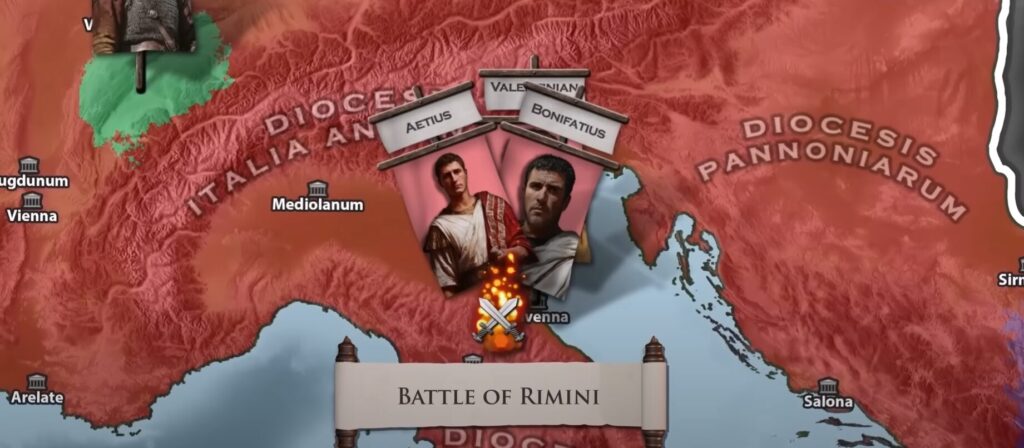
Honorius Moves His Capital and Handles the Crisis
Emperor Honorius, unable to defend the city, stayed in Ravenna instead of Rome. Ravenna was easier to defend from attack. While in Ravenna, Honorius tried to keep his power, but his control was always at risk.
He faced new threats, including a rebellion from Constantine III in Gaul and a revolt by Heraclianus in North Africa. In both cases, Honorius sent his top general, Constantius, to put down the uprisings. The defeats of these rebels showed anger and loss of trust in Rome’s leadership.
Important events after Honorius moved:
| Event | Year | Outcome |
|---|---|---|
| Honorius relocates to Ravenna | ~410 | City better defended, Rome left exposed |
| Constantine III’s revolt | 411 | Uprising stopped, but showed weakness |
| Heraclianus’ revolt | 412-413 | Ended quickly, but trade badly damaged |
Facing crisis after crisis, Honorius did what he could to keep the empire together, but Roman authority was never fully restored. The leadership’s move to Ravenna, and the empire’s willingness to grant land to outsiders, signaled a new, weaker chapter for Rome.
Political Instability and Seizure of Power
Uprisings Led by Constantine in Gaul and Britain
Constantine took advantage of the chaos in the Western Roman Empire. He started to rule almost on his own in Britain and later moved into Gaul. Honorius, the current emperor, struggled to keep control from his stronghold in Ravenna. After the destruction caused by the Visigoths in Italy, Honorius sent his general, Constantius, to deal with Constantine.
Key Events:
- Constantine controlled Britain and parts of Gaul.
- Constantius led the campaign to stop him.
- Constantine and his son were promised safety but were executed after they surrendered.
- Their heads were sent to Honorius, showing that authority had returned to the emperor.
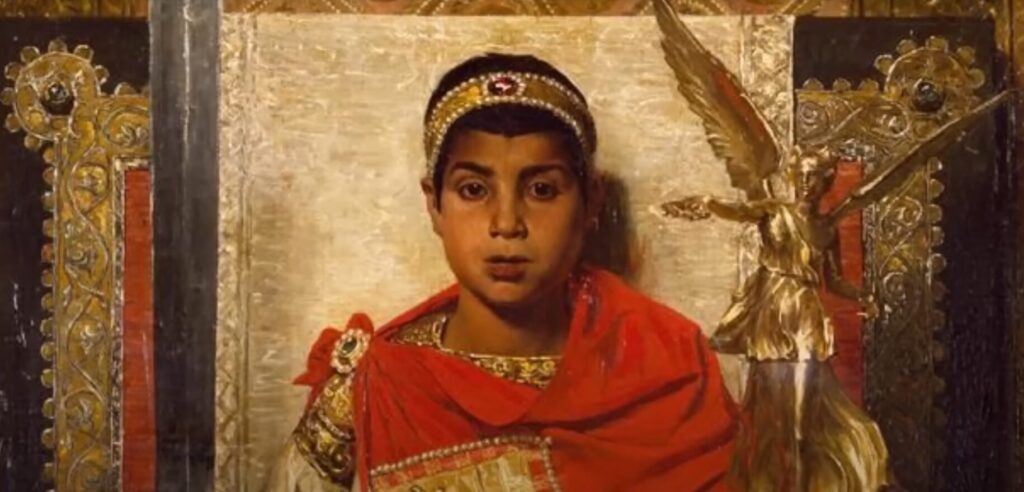
The Defeat and Execution of Constantine
Honorius’s forces under Constantius eventually captured Constantine and ended his rule in the west. Even though he surrendered peacefully, both he and his son were killed. This moment of regained control was used to signal that uprisings would not be tolerated.
| Event | Year | Outcome |
|---|---|---|
| Constantine’s Revolt | By 411 | Constantine executed |
| Constantius Acts | 411 | Honorius’s authority returns |
Heraclianus’ Uprising in North Africa
Soon after Constantine was defeated, another threat emerged. Heraclianus, who governed North Africa, rebelled in 412. He was upset by being passed over for higher military command. He tried to weaken Rome by holding back grain shipments from Carthage. Heraclianus launched an invasion toward Italy, but was quickly outnumbered and had to retreat. He was soon killed in Carthage.
Highlights:
- Heraclianus blocked grain shipments to Rome.
- He failed to defeat Honorius’s larger army.
- Heraclianus was killed in Carthage after retreating.
This revolt showed how local officials were acting on their own. It also showed Rome’s loss of control in far off regions like North Africa, Britain, and Spain. In these areas, Roman influence was quickly fading as other groups took charge.
Provinces Slip Away
Breakaway of North African Territories
North Africa had long provided grain that fed Rome, especially from Carthage. When the province’s governor, Heraclianus, rebelled, he stopped grain shipments and sent his troops toward Italy. Even though his attempt failed and he was killed soon after, this event showed how governors could act almost like independent rulers. The loss of these supplies left Rome even weaker and more vulnerable.
Key Points:
- North Africa’s grain exports were vital to Rome
- Heraclianus’ revolt cut off supplies, foreshadowing later losses
- After the failed revolt, killings and power shifts showed instability
Erosion of Roman Power in Spain and Britain
Roman control across Hispania and Britain faded quickly. Governors and military leaders started to ignore orders from Rome, ruling as they saw fit. In Britain, Constantine III acted without much input from the emperor and even launched his own campaigns. Though Rome reclaimed authority for a short time, these regions became harder to govern and soon operated outside imperial control.
Signs of Weakness:
- Regional authorities became more independent
- Central commands from Rome were often ignored
- Britain and Spain started breaking away from the empire
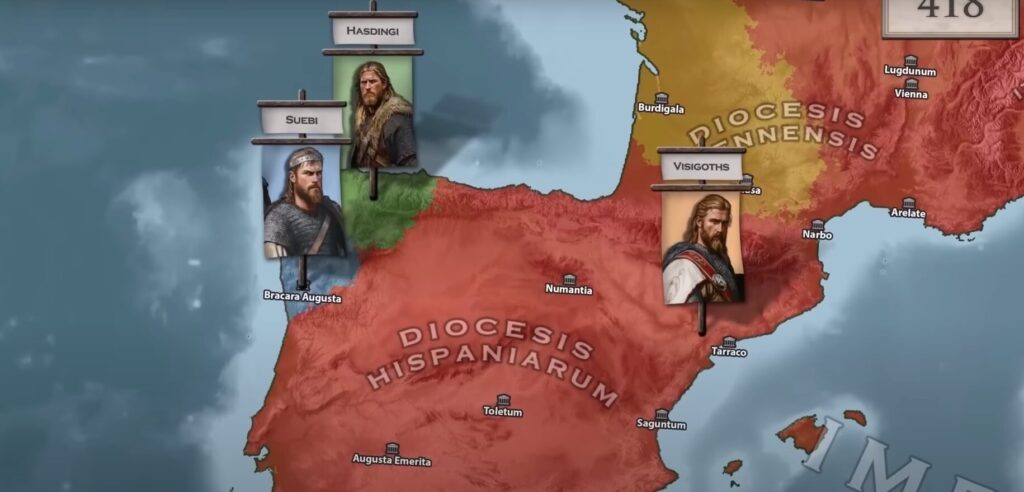
Vandal Incursions and the Battle Near Tarraco
The Vandals, alongside the Alans, invaded Hispania and defeated Roman forces at the battle near Tarraco. This loss pushed the last Roman soldiers out of large parts of Spain. The Vandals then set their sights on North Africa, eventually crossing into the region and moving eastward. These advances seriously weakened Rome’s hold over its western provinces.
| Event | Result |
|---|---|
| Battle near Tarraco | Vandal victory, Roman retreat from Hispania |
| Vandals move to North Africa | Start of further Roman losses in the south |
Roman leaders tried to repel these attacks but failed to keep control over their territories. The map of the empire was changing fast, and Rome no longer dominated large areas it had once ruled for centuries.
Foederati and Barbarian Settlements
Visigoths Receive Territory in Southwestern Gaul
In 418 AD, the emperor agreed to allow the Visigoths to settle in southwestern Gaul, an area now known as Aquitaine. This move was a step beyond earlier arrangements with other tribal groups. The Visigoths were granted land and recognition, allowing them to build their own kingdom not far from Italy.
Key Details:
- This agreement with the Visigoths was different from past practices, as it allowed a large group of outsiders to form their own power center within Roman territory.
- Only two centuries earlier, Rome would not have allowed hostile tribes anywhere near its heartland.
- The decision came at a time when the Roman army was overstretched and unable to counter every threat.
The table below gives a quick comparison:
| Issue | Before 418 AD | After 418 AD |
|---|---|---|
| Settlement | Barbarians kept out | Visigoths inside empire |
| Control | Direct Roman rule | Tribal self-rule allowed |
| Location | At the frontiers | Inside southwestern Gaul |
Impact of Allowing Barbarians to Settle
Allowing groups like the Visigoths to settle inside the empire had serious outcomes. While it was meant to bring peace, violence still broke out. For example, the Visigoths attacked Arles in 425 AD but were stopped by a Roman general.
Consequences included:
- The empire lost control over key regions as tribal groups became more independent.
- The policy showed Rome could not defend its borders as before.
- This pattern encouraged other tribes to claim Roman land for themselves.
- Even generous deals failed to stop further conflicts.
The changes set a model for future kingdoms that would appear in lands once controlled by Rome.
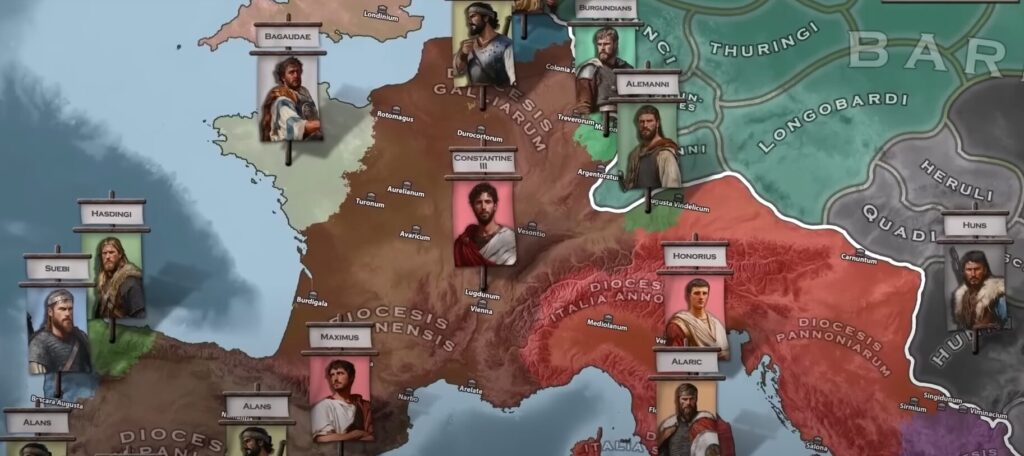
Ongoing Visigothic Danger
Attack on Arles and King Theodoric
After being given land in southwestern Gaul, the Visigoths did not remain peaceful. They pushed beyond their agreed borders, moving to attack the city of Arles in 425 AD under their new ruler, Theodoric. Even though they had received territory and power, these terms failed to stop their ambitions.
Key Points:
- The Visigoths laid siege to Arles in hopes of expanding their influence.
- The assault showed they were not satisfied with previous agreements.
- The Romans, despite many challenges, managed to defend the city and pushed back the attackers.
| Year | Event | Outcome |
|---|---|---|
| 425 | Visigoths besiege Arles | Roman defense holds |
Leadership of Military Commander Aetius
The Roman general Aetius played a critical role in stopping the Visigoth advance. His leadership during the siege was a turning point.
- Aetius organized the Roman forces and managed to repel the Visigoths.
- He forced Theodoric to accept new terms, putting an end to the immediate threat.
- These efforts helped maintain some Roman control, even though the empire was struggling on many other fronts.
Aetius’ actions highlighted the ongoing need for strong military leadership to face outside threats, especially from groups like the Visigoths who continued to challenge Roman rule even after being granted land.
Theodosius II’s Leadership and Laws in the Eastern Empire
Efforts to Avoid War with the Huns
Theodosius II led the Eastern Roman Empire while outside threats kept mounting. Strong figures in his court guided many of his decisions, especially when he was young. Under the direction of his advisor Chrysaphius, he tried to keep peace with the Huns by giving them payments and meeting their demands.
These peace deals were expensive and strained the Empire’s resources. They also did little to make the eastern borders safer. The Huns continued to attack, and their power increased to the point where they threatened Constantinople, the Eastern capital. This policy is often seen as not successful in keeping the Huns from being a serious danger.
| Year | Action Taken | Result |
|---|---|---|
| 408 AD | Theodosius II becomes emperor | Empire led by regency and advisors, policy of appeasement begins |
| 430s–440s AD | Payments made to Huns | Continued raids, rising cost and instability |
Security Struggles and Negotiations with Rivals
During his rule, the Eastern Empire faced major military and political issues. Theodosius II was often unable to rely on his own army to stop threats like the Huns. Many decisions came from his advisors, which sometimes led to weak responses to attacks.
While the East attempted to avoid direct war with strong enemies, violence and pressure from the Huns increased. Theodosius II’s efforts included not just defense, but also big legal changes. He ordered the creation of the Theodosian Code, a collection of laws that helped organize the empire’s rules and supported the power of Orthodox Christianity. Even though these reforms brought order to Roman law, they did not fix the problem of the empire’s weakening military strength.
Key Points:
- Military force alone was not enough to stop invasions.
- Theodosius II relied on peace treaties, but they were costly and often failed.
- Creating the Theodosian Code showed the empire could still manage large projects, even as it struggled to defend itself.
Summary Table of Policy Results
| Policy | Intended Effect | Outcome |
|---|---|---|
| Peace with Huns | Protection, stability | Resources drained, borders still at risk |
| Legal reforms | Stronger government | Better laws, no real military gain |
The Theodosian Code and Changes in Civic Life
Creating Consistency in Law
The Theodosian Code was made to bring together a large list of rules and laws from past emperors, starting with Constantine. It aimed to make the rules easier to understand across the whole empire, both east and west. Instead of many scattered orders, the code made laws clear and unified, which helped citizens and officials know what was expected.
This project took almost ten years to finish. It gathered, organized, and replaced confusing or repeated laws with a single, easier system. The new code was a big effort by the government to maintain order, even when the empire faced many problems and outside threats.
Lasting Effects on Religion and Legal Systems
The Theodosian Code was important for the role it gave to Christianity. It firmly supported the Nicene, or orthodox, form of the Christian faith. By putting these beliefs into law, it tried to stop the spread of other versions of Christianity, like Arianism.
Below is a sample of how law and church were linked:
| Topic | Approach in Theodosian Code |
|---|---|
| Legal Clarity | Set out laws in an organized manner |
| Religion in Law | Favored orthodox Christianity |
| Opposition | Targeted rival Christian beliefs |
By making religious policies part of the law, the code helped set standards that would be followed for centuries. It also acted as a guide for future collections of laws in Europe, showing the lasting power of Theodosius II’s reforms.
Succession and Authority After Honorius
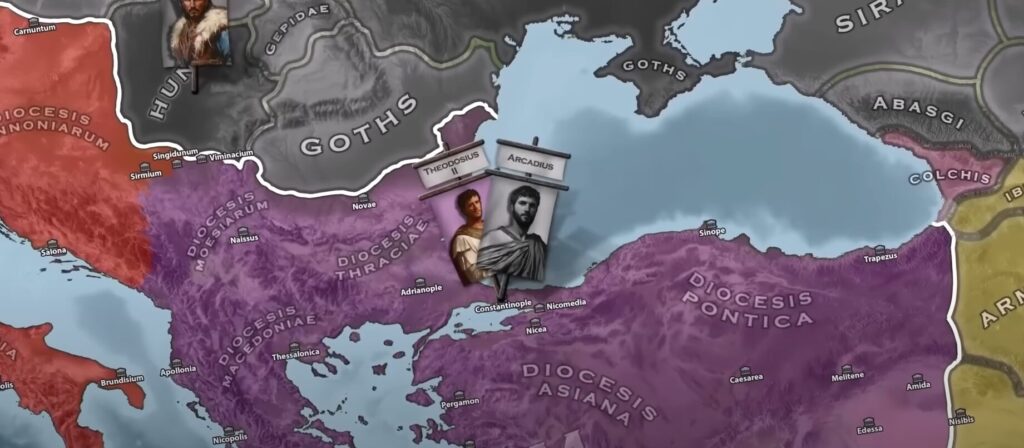
The Rule of Joannes and Valentinian III
Following Honorius’ death in 423 AD, there was confusion over who would take the throne in the West. Joannes, a high-ranking official, made a claim and held power for about two years. His rule was short and faced strong opposition. Eventually, eastern emperor Theodosius II sent forces to remove him. After Joannes was defeated, young Valentinian III was made the new western emperor. He was the son of Constantius, a trusted general of Honorius.
Valentinian III ruled the West, while Theodosius II continued in the East. For a time, there was a partnership between the two emperors, but real power in the West was not always in Valentinian’s hands.
Galla Placidia’s Role in Power
During Valentinian III’s early reign, he was too young to govern on his own. His mother, Galla Placidia, became the key decision-maker in the western empire. She acted as regent, setting government policies and responding to threats.
Galla Placidia tried to bring back order and stability. She worked closely with top military leaders and focused on keeping the government running. Her leadership proved important while her son was still a minor.
New Efforts to Protect and Fix Western Europe
With outside threats growing and resources shrinking, leaders needed to make changes. Efforts included:
- Reorganizing armies to better defend key frontiers
- Trying to repair government functions
- Looking for ways to secure enough food and supplies
These reforms faced major problems, like reduced money and territory. Despite hard work, challenges continued and the empire struggled to hold back groups like the Vandals and Visigoths.
Table: Key Challenges and Responses
| Challenge | Response |
|---|---|
| Loss of provinces (Africa, Hispania) | Military reorganization |
| Food shortages | Efforts to protect grain supply |
| Barbarian invasions | Treaties and defensive battles |
Leaders tried to strengthen what remained of the western empire, but the growing number of attacks made these attempts less effective over time.
The Vandal Takeover of North Africa
Moving from Spain to Africa
The Vandals left their lands in Spain and made their way into North Africa in 429 AD. They traveled with a large group, including families and warriors. Their journey took them across the Strait of Gibraltar. Once in Africa, they advanced quickly, taking over different areas along the coast.
Key Points:
- Left Hispania due to growing threats and unrest
- Crossed into Africa by sea
- Moved through what is today Morocco and beyond
Partnership with the Alans
The Vandals did not act alone. They formed an alliance with the Alans, a strong nomadic group. This partnership helped both groups become more powerful. Together, they captured cities and forced local leaders to surrender.
Main reasons for success:
- Shared military resources
- Combined leadership
- Increased troop numbers
| Group | Role in Alliance |
|---|---|
| Vandals | Led main advance |
| Alans | Supported in battles |
Effects on Roman Control
The Vandal conquest was a disaster for Roman North Africa. The region was important because it produced much of the grain that fed Rome. When the Vandals took control, they interrupted these food supplies. Roman power in North Africa dropped sharply, and the loss hurt the whole western empire.
Roman Issues After the Vandal Takeover:
- Grain shipments stopped
- Weakened control over provinces
- Increased independence of local rulers
The Vandals’ actions made it even harder for Rome to recover its former strength. The western empire soon faced even greater challenges.
